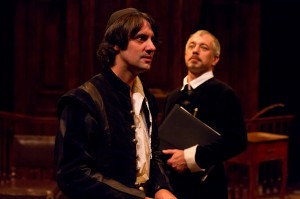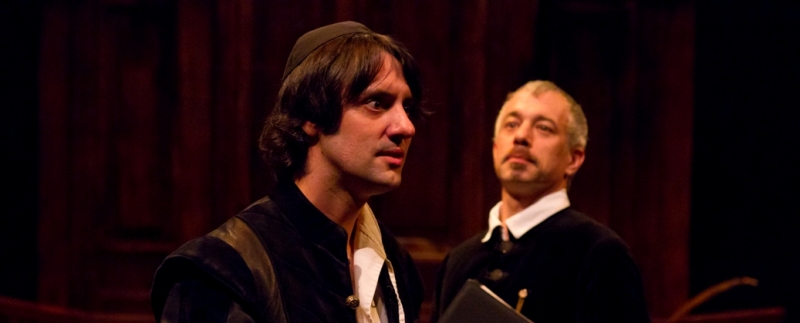
Sam Henderson as Baruch de Spinoza and Seth Reichgott as Abraham van Valkenburgh in Lantern Theater Company’s NEW JERUSALEM. (Photo credit: Mark Garvin)
Is attacking two of the most educated and progressive historic religious cultures the best way to begin a dialogue about free-thinking and tolerance? David Ives’ vitriolic fantasy about the trial of Spinoza shows little tolerance for either the Protestants or Sephardic Jews of 17th-century Amsterdam, and equally little historical accuracy.
In fact, there is minimal documentation on the excommunication of the young Jewish philosopher, which took place at the Talmud Torah Congregation in Amsterdam on July 27, 1656; no transcript of the proceedings, no specific reason stated as to why Spinoza was expelled, and no record of who was in attendance–including Spinoza himself. The sole extant document is the text of the official cherem in Spanish, which is generally regarded as an extremely severe and unforgiving anathema: “. . . Cursed be he by day and cursed be he by night; cursed be he when he lies down, and cursed be he when he rises up; cursed be he when he goes out, and cursed be he when he comes in . . .”
Considering the serious lack of evidence, Ives has taken excessive liberties with the feigned ‘courtroom drama’ by conflating characters, confusing names, creating conversations, inventing interrogations, and pitting Protestants against Jews—two groups united in Amsterdam through their brutal persecution under the Spanish Inquisition. He uses this dramatic method as a platform to express Spinoza’s philosophy as defined in his writings and in subsequent exegeses. Unfortunately, because Ives’ premise is based on an actual historic event in the life of a real person, and his play ends with the intoning of the true censure, this fiction runs the risk of being taken as fact; perhaps a disclaimer in the program would be useful to distinguish between the two.

Sam Henderson, Kittson O’Neill, David Bardeen and David Blatt in the excommunication scene in Lantern Theater Company’s NEW JERUSALEM. (Photo credit: Mark Garvin)
The ‘artistic license’ taken by the playwright notwithstanding, Lantern has managed to offer a well-acted and well-designed production. Under Charles McMahon’s direction, David Bardeen, David Blatt, and Seth Reichgott turn in especially powerful performances, filled with both the passion and the venom with which Ives imagines their characters; and Sam Henderson is captivating as the ever thinking, often arrogant, and eminently likeable 23-year-old Spinoza, still in the process of figuring out the complex ideas that caused his estrangement from the community of his birth.
The design team of Nick Embree (set), Maggie Baker (costumes), Shon Causer (lighting), and Nick Rye (sound) clearly did their homework, and created an artistically refined and convincing 17th-century ambiance, from the floor pattern, furnishings, and windows, to the historic dress and hairstyles, to the black wax candle, Ark of the Covenant, Books of the Law, and solemn horn-blowing of the cherem ritual.
NEW JERUSALEM saw the largest pre-sale of tickets in the Lantern’s 18-year history; due to popular demand, the show has been extended into November. In conjunction with the fictional production, Lantern is offering a series of educational programs, including a FALL PHILOSOPHY FESTIVAL on THEATER AND THE AGE OF REASON, to explore the Sephardic experience in Europe and Spinoza’s lasting influence on art, literature, and philosophy.
Postscript:
There were many wealthy Sephardic businessmen, art collectors, and writers in 17th-century Amsterdam, and the following quote from one of them–an exact contemporary of Spinoza– expresses a very different sentiment than found in Ives’ play:

Spinoza’s burial site at the New Church in The Hague. (Photo credit: Roel Wijnants)
“In no place in the world do [the Jews] have less fear than in Amsterdam, as much because of the liberty of conscience of the Seven United Provinces as because of the kindness of its talented inhabitants . . . the city benignly shelters the people of Moses who learn from the Sacred Prophecies that those who try to destroy them will be destroyed, and that the Nations that protect them will be rewarded by the Divine Hand.” (Miguel de Barrios, TRIUMPHO DEL GOVIERNO POPULAR Y DE LA ANTIGÜEDAD HOLANDESA, Amsterdam, 1683).
Following his excommunication, Spinoza lived out the remainder of his short life in the Dutch Republic. After he died at his home in The Hague in 1677, he was buried on hallowed Christian ground, in the churchyard of the Nieuwe Kerk, with his funeral procession “being attended by many Illustrious persons and followed by six Coaches” (this according to Johannes Colerus, THE LIFE OF SPINOZA, London, 1705—an early biography based on eyewitness accounts and original documents).
NEW JERUSALEM, THE INTERROGATION OF BARUCH DE SPINOZA
AT TALMUD TORAH CONGREGATION: AMSTERDAM, JULY 27, 1656
by David Ives
Directed by Charles McMahon
October 6-November 6, 2011
Lantern Theater Company
St. Stephen’s Theater
10th & Ludlow Streets
Philadelphia, PA
215.829.0395
www.lanterntheater.org

